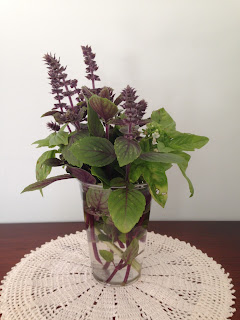It has come to pass that the Town of Greenwich needs a four foot one inch easement along the side of our house so it can replace a storm drain on our neighbor’s property. This is not a happy development. When I moved to Old Greenwich in 1995 I assumed the yard from Charlotte and Joe, my in laws. It was their home for over 50 years. The hemlock hedge around the property was 10 feet tall and 6 feet wide and in decline. The yews by the front steps left little room to reach the porch. I could see the charm of the house built in 1917.
After my husband, Jay took his chainsaw to the overgrown shrubs and I dug out the roots, it was time to plant anew. It was also time to sell my parents' home where they had gardened for 60 years and our own family’s eight acres where I collected many wonderful varieties of flowers, shrubs and herbs. With less than a quarter acre to work with and large Norway Maple trees close by in neighbors’ yards I took a Noah’s Arc approach and transplanted my most treasured plants.
Now I must plan a rescue removal of the plants growing in the 160 foot long and five foot wide bed that includes the proposed easement. Perhaps we can negotiate a fair arrangement to save the two specimen Chamaecyparis obtusa trees I planted twenty years ago that have grown into handsome specimens. The fifteen year old flowering “Stewartia” accenting my steps will be chopped down.
The town’s engineer asked if this list was accurate, he could not imagine growing all these plants. I will admit that if you are not a gardener it could raise eyebrows. But this is the list that I made in May as I weeded and mulched the plants along my border garden.
Syringa - 2 lilac shrubs (one white and one dark purple)
Kolkwitzia amabilis - Beauty Bush - 17 years, gift from my father at my mother’s passing - seedling of his plant
Clethra - pink flowering gift from friend 18 years
Narcissus - 30 Daffodils
Hemerocallis - 25 Daylily plants various hybrids and rare selections (no wild orange)
Hosta Blue Cadet - 10
Hosta Francis Williams - 3
Hosta Mrs Allen - 5
Adiantum - 12 Maidenhair fern
Asarum europaeum - European ginger
Sanguinaria canadensis - Native wildflower - single bloodroot
Hydrangia - 4 varieties established shrubs
Iris Japanese 3 varieties(White heron, rare purple/white, Eleanor Perry)
Iris Henry Shaw - 10 white German iris
Iris pumilla - 25 dwarf early flowering purple
Iris dwarf cherry - 15 semi-dwarf red iris
Iris dwarf yellow - 15 semi-dwarf yellow iris
Iris - yellow flag
Iris cristata - 50 (rare native)
Paeonia lactifolia - single flowered peony - 3 pink
Polygonatum - Variegated Solomon seal
Rubus - Jewel black raspberry (8 plants) established and productive
Rubus - red raspberry (5 plants) established and productive
Cyanococcus - 2 hybrid blueberry shrubs (10 years)
Podophyllum - Mayapple
Epimedium - yellow
Muscari - grape hyacinth
Cornus florida - white Dogwood 50 years old
Paeonia - Double pink peony
Nepeta cataria - Catnip
Levisticum officinale - lovage herb
Allium schoenoprasum - chives herb
Allium tuberosum - garlic chives herb
Rosa Floribunda - 3 roses (pink and red)
Hakonechloa m. aureola - Golden dwarf Japanese grass
Buddleia - 2 Butterfly bushes (purple)
Angelica - 10 culinary herb
Buxus - English boxwood 17 years - rooted from a bouquet at my mother's funeral
Artemisia albula - Wormwood Silver King
Malva - Pink
Digitalis (- pink foxglove) first planted 1979
Helianthus tuberosus - Sunchoke
Silene coronaria - Rose Campion
Lismachia purpurea - Purple Loosestrife
Platycodon - balloon flower
Onoppordum acanthum - Scotch Thistle










